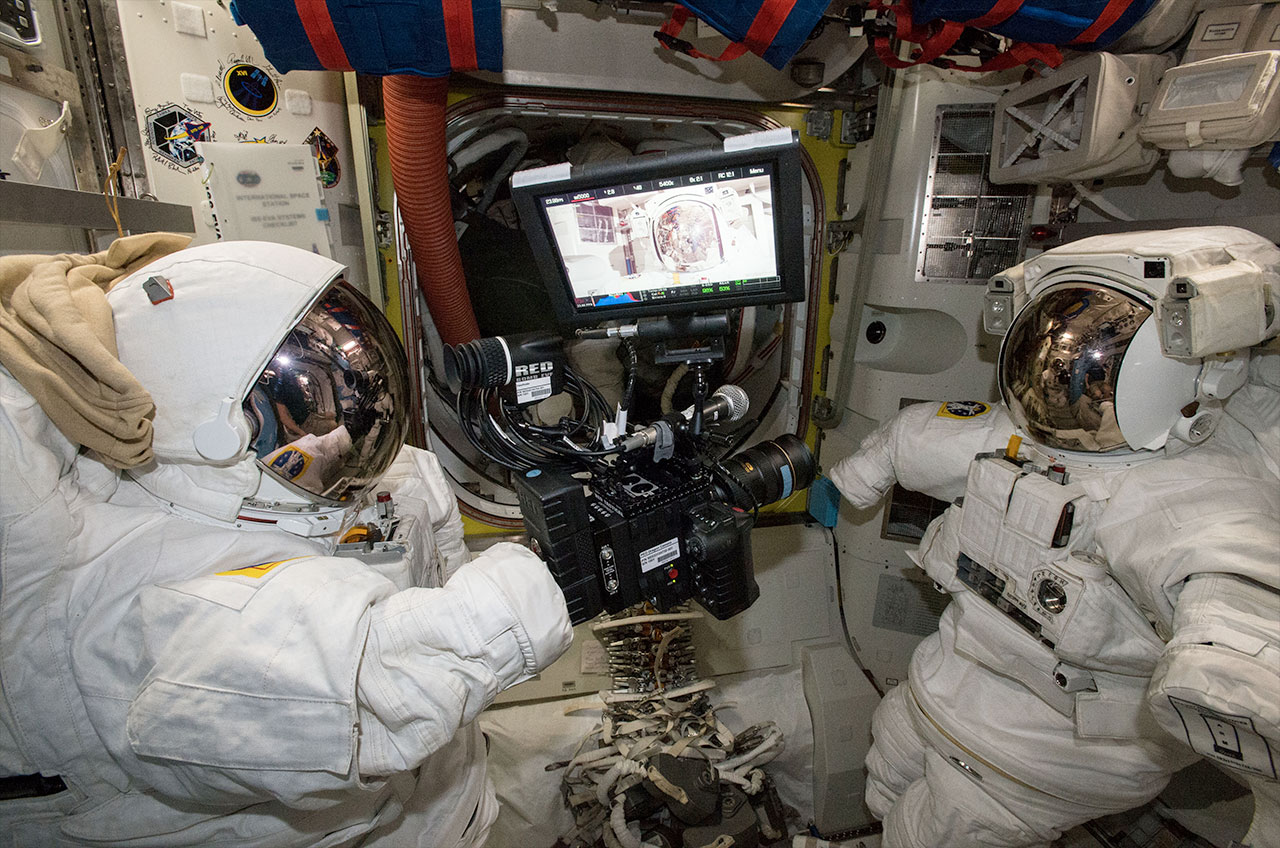NASA Returns First RED Camera From Orbit, Demos First Live 4K Video From Space

NASA has given new definition to the old saying, "what goes up must come down."
The U.S. space agency presented two high-definition firsts on Wednesday (April 26), producing the first-ever live 4K video from orbit and returning one of the first ultra-high def cameras* to be used on the International Space Station to the company behind it.
"What goes up must come down, except when what goes up goes into outer space," said Sam Matheny, executive vice president and chief technology officer of the National Association of Broadcasters (NAB), on Wednesday at the organization's annual show in Las Vegas. "And that is what makes the first RED camera to go to the International Space Station so special."
"This [RED Epic Dragon] camera was a vital tool to further our scientific studies and the interests of NASA [for] space exploration," he said. "It recently returned to Earth, so it did successfully come down." [Lightning and Mystery Objects Spotted by Space Station (Video)]
In a brief ceremony preceding the first live 4K stream from the station using another RED camera launched to orbit), the first flown-in-space Epic Dragon was presented to Jarred Land, president at RED Digital Cinema.
"NASA and RED collaborated to fly a RED Epic Dragon to the International Space Station," said Dylan Mathis, NASA space station communications manager, who with Rodney Grubbs, NASA imagery experts program manager, handed the camera to Land. "This camera has served us very well and was returned to Earth after 437 days in space."
Launched in January 2015 on SpaceX's fifth Dragon cargo spacecraft to supply the space station under a commercial contract with NASA, the Epic Dragon (of no relation to the SpaceX ship) enabled NASA to capture science data and deliver scenes from space like never before.
Breaking space news, the latest updates on rocket launches, skywatching events and more!
Capable of filming at resolutions ranging from conventional HDTV up to 6K, the Epic Dragon camera's frame rate and resolution were able to reveal more information when used to record investigations, giving researchers a valuable new tool on board the space station, NASA said.
"This is a huge leap in camera technology for spaceflight," stated Grubbs in a 2015 NASA interview. "These cameras have large sensors capable of very high resolution imaging at high frame rates. It is like having a high speed 35 mm motion picture film camera, but it is compact, can use [the] lenses we already have up there, and it is digital. No film to return to Earth."
NASA used the Epic Dragon to capture views of Earth and its astronauts' activities — including station crew members manipulating floating balls of water — which were posted to YouTube after being saved and sent down from space. On Wednesday, Expedition 51 commander Peggy Whitson and flight engineer Jack Fischer did much the same thing, inserting effervescent tablets and food coloring drops into the water globules, but this time they did it live.
"With these new cameras and technologies, we are able to ... capture different science for some of our experiments — ultra-slow motion for some of the effects that are very short lived, yet very important," said Fischer. "I think even more important is the inspirational aspect, because 4K and ultra high-def actually makes you feel like you you're there."
"I mean, if you look really close, you can probably see into my pores right now," he added, turning his head towards the camera to show his cheek. "Granted, nobody wants to see there, but everybody wants to see the Earth from this vantage point. And by looking down at the Earth with this amazing new technology, we are able to inspire an entire new generation of explorers."
The camera presentation and live broadcast were part of a session titled, "Reaching for the Stars: Connecting to the Future with NASA and Hollywood," which included Grubbs, astronaut Tracy Caldwell Dyson and Khawaja Shams, vice president of engineering at AWS Elemental, which helped produce the live stream.
"As a technologist, I was inspired by the fact we now have this technical feat of 4K video coming [live] from space," said Shams. "But as I watched the video, I found my own passion for space being reinvigorated and I realized that the video is just the vehicle. It is the content that I am most excited about."
*Prior to the first RED Epic Dragon camera arriving on the space station, IMAX launched a Canon C500 UHD camera to the space station to support the film "A Beautiful Planet" in September 2014.
See the presentation of the first RED Epic Dragon camera and watch the first live 4K video from space at collectSPACE.
Follow collectSPACE.com on Facebook and on Twitter at @collectSPACE. Copyright 2017 collectSPACE.com. All rights reserved.

Robert Pearlman is a space historian, journalist and the founder and editor of collectSPACE.com, a daily news publication and community devoted to space history with a particular focus on how and where space exploration intersects with pop culture. Pearlman is also a contributing writer for Space.com and co-author of "Space Stations: The Art, Science, and Reality of Working in Space” published by Smithsonian Books in 2018.
In 2009, he was inducted into the U.S. Space Camp Hall of Fame in Huntsville, Alabama. In 2021, he was honored by the American Astronautical Society with the Ordway Award for Sustained Excellence in Spaceflight History. In 2023, the National Space Club Florida Committee recognized Pearlman with the Kolcum News and Communications Award for excellence in telling the space story along the Space Coast and throughout the world.


